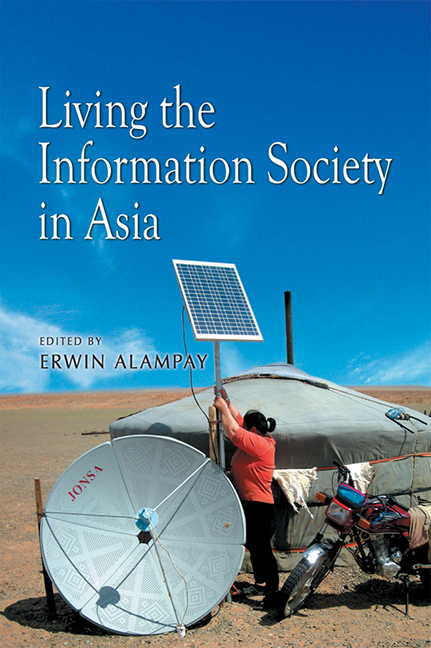Book contents
- Frontmatter
- Contents
- Foreword
- Preface
- List of Abbreviations
- Contributors
- Introduction: Perspectives of ICT Research in Asia
- 1 What Would Durkheim Have Thought? Living in (and with) the Information Society
- 2 What Is a Mobile Phone Relationship?
- 3 Technologies of Transformation: The End of the Social or the Birth of the Cyber Network?
- 4 Becoming Mobile in Contemporary Urban China: How Increasing ICT Usage Is Reformulating the Spatial Dimension of Sociability
- 5 Mobile Religiosity in Indonesia: Mobilized Islam, Islamized Mobility and the Potential of Islamic Techno Nationalism
- 6 Moral Panics and Mobile Phones: The Cultural Politics of New Media Modernity in India
- 7 Stories from e-Bario
- 8 Life and Death in the Chinese Informational City: The Challenges of Working-Class ICTs and the Information Have-less
- 9 Institutional Responses to GIS Adoption for RPTA in Local Governments
- 10 Customer Acquisition among Small and Informal Businesses in Urban India: Comparing Face-to-Face and Mediated Channels
- 11 The View from the Other Side: The Impact of Business Process Outsourcing on the Well-being and Identity of Filipino Call Centre Workers
- 12 Empowering Thai Homeworkers through ICTs
- Index
6 - Moral Panics and Mobile Phones: The Cultural Politics of New Media Modernity in India
Published online by Cambridge University Press: 21 October 2015
- Frontmatter
- Contents
- Foreword
- Preface
- List of Abbreviations
- Contributors
- Introduction: Perspectives of ICT Research in Asia
- 1 What Would Durkheim Have Thought? Living in (and with) the Information Society
- 2 What Is a Mobile Phone Relationship?
- 3 Technologies of Transformation: The End of the Social or the Birth of the Cyber Network?
- 4 Becoming Mobile in Contemporary Urban China: How Increasing ICT Usage Is Reformulating the Spatial Dimension of Sociability
- 5 Mobile Religiosity in Indonesia: Mobilized Islam, Islamized Mobility and the Potential of Islamic Techno Nationalism
- 6 Moral Panics and Mobile Phones: The Cultural Politics of New Media Modernity in India
- 7 Stories from e-Bario
- 8 Life and Death in the Chinese Informational City: The Challenges of Working-Class ICTs and the Information Have-less
- 9 Institutional Responses to GIS Adoption for RPTA in Local Governments
- 10 Customer Acquisition among Small and Informal Businesses in Urban India: Comparing Face-to-Face and Mediated Channels
- 11 The View from the Other Side: The Impact of Business Process Outsourcing on the Well-being and Identity of Filipino Call Centre Workers
- 12 Empowering Thai Homeworkers through ICTs
- Index
Summary
INTRODUCTION
Stanley Cohen's (1980) concept of “moral panics” and his conceptualization of “folk devils” are as relevant today as they were during the 1970s. Today they find immense scope in examining the “moral panics” engineered around the technologies of mobile telephony and the Internet, particularly in the contexts of new media modernity.
The rapid proliferation of mobile phones in India in recent times, along with the rise of the information technology-enabled services sector and Internet-based media, has come to define the age of new media modernity in India. Such a proliferation can not go without attendant problems for the society and the individual users of mobile phones. One important facet of the new media modernity is its crisis state. It is as crisis driven as Gidden's (1991) age of high modernity. Moral panics concerning new media technologies have multiplied in India in tune with the proliferation of mobile and Internet-based media, at least going by the constructions engineered by media and other agents. This chapter examines the nature and operationalization of such moral panics in the context of cultural politics of new media modernity in India.
MORAL PANICS, SOCIAL CONTROL AND CONTROL SOCIETIES
Stanley Cohen's work on the moral panics caused by the media coverage of mods and rockers is a classic with an enduring appeal. According to Cohen (1980, p. 9), moral panics arise when
a condition, episode, person or group of persons emerges to become defined as a threat to societal values and interests; its nature is presented in a stylized and stereotypical fashion by the mass media; the moral barricades are manned by editors, bishops, politicians and other right-thinking people; socially accredited experts pronounce their diagnoses and solutions; ways of coping are evolved or (more often) resorted to; the condition then disappears, submerges or deteriorates and becomes more visible.
In our times, there is a need to push the agenda of moral panics research to higher levels. One such plane is where moral panics are revealed not by the sociology of social control (as posited by Cohen), but by the praxis of moral panics and control societies. To get a clear introduction to the agenda and challenges thrown up by control societies, one need not go any further than the two dominant notions of control societies in Western academic thought.
- Type
- Chapter
- Information
- Living the Information Society in Asia , pp. 93 - 108Publisher: ISEAS–Yusof Ishak InstitutePrint publication year: 2009

